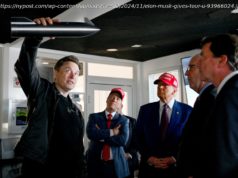Trump is pounding away on the themes of faster economic growth and more take-home pay, arguing that his plan will make the economy great again.
Much as President Donald Trump did in his command performance before the U. N. when he took back control of U. S. foreign policy, the president has now seized and energized the tax-cut issue.
Almost daily, he is pounding away on the themes of faster economic growth and more take-home pay, arguing that his plan will make America’s economy great again.
This is ‘Trumpian’ leadership at its best.
«Under my administration,» Trump told the National Association of Manufacturers last week, «the era of economic surrender is over.»
The highlights of Trump’s plan are as follows: It would slash large and small business tax rates, double the standard deduction for middle-income folks, make the whole tax code simpler by eliminating unnecessary deductions, repeal the death tax, and end the alternative minimum tax.
As usual, Democrats say the president’s plan is a hand-out to the rich. But in a recent speech in Indianapolis, Trump asked: Why can’t this be a bipartisan tax cut bill? He even quoted Democrat John F. Kennedy, who said, «The right kind of tax cut at the right time. . is the most effective measure that this government could take to spur our economy forward.»
He also reminded his audience that President Reagan’s tax cuts were passed with significant bipartisan majorities.
But today’s Democrats have written JFK’s tax story out of the history books (never mind Reagan’s).
Key tax-writing committees are now polishing the Trump plan, fine-tuning it to pass the Senate with 51 votes. However, there are a couple of key points that need clarifying.
The argument that the U. S. is doomed to 2 percent or less growth – commonly called «secular stagnation» – no matter what we do in terms of tax policy, is nonsense.
During the JFK era, across-the-board tax cuts produced annual growth above 5 percent. And after tax cuts were fully implemented in 1983, real growth averaged 4.6 percent for the remainder of Reagan’s presidency.
Treasury Secretary Steven Mnuchin and National Economic Council Director Gary Cohn are touting the 3 percent growth scenario, saying it will pay for the tax cuts. But the naysayers refuse to admit that tax-rate incentives matter.
Let’s take one example from the Trump tax plan: Corporations today are taxed at 35 percent. That means, for every extra dollar of profit, a company keeps 65 cents. But the president has agreed on a 20 percent corporate tax rate. So, for the extra dollar earned, the private company would keep 80 cents.
That’s a massive incentive reward of 23 percent. Do we really think businesses will not be affected by this? That defies logic.
And as supply-side guru Art Laffer points out, the incentive reward of a lower business tax rate will reduce tax avoidance and sheltering. It’s another solid point mainstream economists continue to ignore.
But the incentive effects don’t stop there. The key to wage growth is productivity. Think of it as efficiency. Large and small businesses need new capital investment to modernize equipment and better train an efficient workforce.
Yet real [inflation-adjusted] wages have barely increased since 2000, alongside virtually no productivity increases and a huge slump in capital formation. That’s the missing link between a 2 and 3 percent economy.
Rather than punish investment, the Trump plan will spur growth across the board. Everyone will benefit.
The supply-side incentive effect also includes the repatriation of trillions of U. S. company dollars lodged overseas to avoid taxes, as well as 100 percent expensing write-offs for new investment of any kind.
Taken together, this plan contains a mountain of incentives.
On the individual side, the sleeper tax detail is the doubling of the standard deduction. As my CNBC colleague Jake Novak points out, this is a huge positive for young millennials (who don’t own much) and folks with no mortgages or homes. It puts more cash in worker’s pockets, simplifies the code, and means that near 80 percent of taxpayers won’t have any deductions.
Slimming income-tax rates from seven to three brackets and cutting income-tax rates in general add even more supply-side incentives to the Trump package.
More money for rich people? Well, the not-rich family of four will be a lot better off with a $24,000 standard deduction. And the non-partisan Tax Foundation calculates that the bottom 80 percent of households get a lower tax burden, while the top 20 percent get a higher burden.
The Republican Party has got to win this issue, preferably this year.
So, a warning: The GOP cannot let archaic process rules prevent good policy. Rules can be changed. Congressional Budget Office (CBO) estimates can be ignored. Parliamentarian decisions can be overridden.
Play hardball, GOP. JFK did it. Reagan did it. And now you have Donald Trump doing it –using all his energy to get a big tax cut that will return prosperity to America’s workers and families, and enhance our strength overseas.
Commentary by Larry Kudlow, a senior contributor at CNBC and economics editor of the National Review. Follow him on Twitter @Larry_Kudlow.






